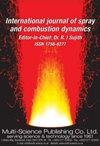Modelling the generation of temperature inhomogeneities by a premixed flame
IF 2.1
4区 工程技术
Q3 ENGINEERING, MECHANICAL
International Journal of Spray and Combustion Dynamics
Pub Date : 2018-06-01
DOI:10.1177/1756827717738139
引用次数: 11
Abstract
The response of a laminar, premixed flame to perturbations of upstream equivalence ratio is investigated and modelled, with emphasis on the generation of ‘entropy waves’, i.e. entropic inhomogeneities of downstream temperature. Transient computational fluid dynamics simulations of two adiabatic lean methane-air flames of different Péclet numbers provide guidance and validation data for subsequent modelling. The respective entropy transfer functions, which describe the production of temperature inhomogeneities, as well as transfer functions for the variation of the heat release, are determined from the computational fluid dynamics time series data by means of system identification. The processes governing the dynamics of the entropy transfer functions are segregated into two sub-problems: (1) heat release due to chemical reaction at the flame front and (2) advective and diffusive transport. By adopting a formulation in terms of a mixture fraction variable, these two sub-problems can be treated independently from each other. Models for both phenomena are derived and analysed using simple 0- and 1-dimensional configurations. The heat release process (1) is represented by a fast-reaction-zone model, which takes into account variations of the specific heat capacity with equivalence ratio in order to evaluate the magnitude of downstream temperature fluctuations with quantitative accuracy. For the transport processes (2), two types of models based on mean field data from the computational fluid dynamics simulation are proposed: A semi-analytical, low-order formulation based on stream lines, and a state-space formulation, which is constructed by Finite Elements discretisation of the transport equation for mixture fraction. Model predictions for the entropy transfer functions are found to agree well with the computational fluid dynamics reference data at very low computational costs.预混火焰产生温度不均匀性的建模
层流预混火焰对上游等效比扰动的响应进行了研究和建模,重点研究了“熵波”的产生,即下游温度的熵不均匀性。两种不同pims数的绝热贫甲烷-空气火焰的瞬态计算流体动力学模拟为后续的建模提供了指导和验证数据。通过系统辨识,从计算流体动力学时间序列数据中确定了描述温度不均匀性产生的熵传递函数和热释放变化的传递函数。控制熵传递函数动力学的过程分为两个子问题:(1)火焰前缘化学反应引起的热释放和(2)平流和扩散输运。通过采用混合分数变量的公式,这两个子问题可以相互独立地处理。这两种现象的模型推导和分析使用简单的0和1维配置。放热过程(1)采用快速反应区模型表示,该模型考虑了比热容随等效比的变化,以便定量准确地评价下游温度波动的幅度。对于输运过程(2),提出了两种基于计算流体动力学模拟平均场数据的模型:一种基于流线的半解析低阶公式,以及一种通过混合分数输运方程的有限元离散化构建的状态空间公式。模型预测的熵传递函数与计算流体力学参考数据非常吻合,计算成本很低。
本文章由计算机程序翻译,如有差异,请以英文原文为准。
求助全文
约1分钟内获得全文
求助全文
来源期刊

International Journal of Spray and Combustion Dynamics
THERMODYNAMICS-ENGINEERING, MECHANICAL
CiteScore
2.20
自引率
12.50%
发文量
21
审稿时长
>12 weeks
期刊介绍:
International Journal of Spray and Combustion Dynamics is a peer-reviewed open access journal on fundamental and applied research in combustion and spray dynamics. Fundamental topics include advances in understanding unsteady combustion, combustion instability and noise, flame-acoustic interaction and its active and passive control, duct acoustics...
 求助内容:
求助内容: 应助结果提醒方式:
应助结果提醒方式:


